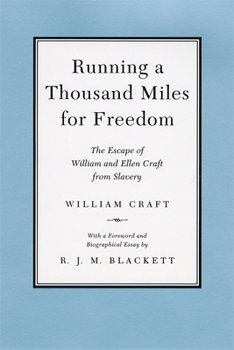Running a Thousand Miles for Freedom: The Escape of William and Ellen Craft from Slavery
Select Format
Select Condition 
Book Overview
Husband and wife William and Ellen Craft's break from slavery in 1848 was perhaps the most extraordinary in American history. Numerous newspaper reports in the United States and abroad told of how the two -- fair-skinned Ellen disguised as a white slave master and William posing as her servant -- negotiated heart-pounding brushes with discovery while fleeing Macon, Georgia, for Philadelphia and eventually Boston. No account, though, conveyed the ingenuity, daring, good fortune, and love that characterized their flight for freedom better than the couple's own version, published in 1860, a remarkable authorial accomplishment only twelve years beyond illiteracy. Now their stirring first-person narrative and Richard Blackett's excellent interpretive pieces are brought together in one volume to tell the complete story of the Crafts.
Format:Paperback
Language:English
ISBN:080712320X
ISBN13:9780807123201
Release Date:January 1999
Publisher:LSU Press
Length:120 Pages
Weight:0.42 lbs.
Dimensions:0.3" x 6.0" x 8.9"
Customer Reviews
5 ratings
Running a Thousand Miles for Freedom; or, the escape of William and Ellen Craft from slavery
Published by Thriftbooks.com User , 18 years ago
overall in good shape- more importantly got here on time for my class!
A Daring Escape to Freedom!!!
Published by Thriftbooks.com User , 22 years ago
Ellen and William Craft were a young (mid-20's) slave couple who made a daring escape to freedom. Light-skinned Ellen cut her hair short and dressed in the suit and tophat of a white planter. Since she was illiterate, her husband William made a sling for her arm, so she had an excuse not to sign hotel registers. And since she had a womanly voice, the couple devised a poultice tied around her jaw indicating she had a bad toothache and could not speak. William played the role of his white massa's slave. And the couple traveled by train, steamship, and wagon to their destination in the north. They soon became popular lecturers in the United States and Europe. This is a remarkable story of daring and bravery and should be read by everyone. Anyone who wants to introduce their children to good historical fiction should get them The Journal of Darien Duff, an Emancipated Slave, The Diary of a Slave Girl, Ruby Jo, and The Journal of Leroy Jones, a Fugitive Slave.
Engrossing
Published by Thriftbooks.com User , 23 years ago
I read this for a college history survey course before it was mistakenly announced that the book was out of print. The book was dropped from the syllabus, but I am glad I read it anyway.The first and shortest part of the book is William Craft's powerful account of how he and his wife Ellen executed a daring escape from servitude in Georgia. Their plan was remarkable in its ingenuity: The almost white Ellen, outfitted with a master's clothes and a poultice on her face to prevent incriminating speech with strangers, and her husband William, disguised as a servant, escaped to freedom in the north. Travelling by rail, the pair exultantly crossed over into Canada and from thence headed for England.The second part of the book is a third person summary of the couple's travels after their ambitious escape. It follows them from Georgia through the slave and free states, in which they were well received and protected (especially in Boston), up to Halifax and across the water to England. I found the final two thirds of the book the most enjoyable, as it treated of foreign travel, in which I have a keen interest. Both portions of the book are beautifully written and often gripping. I hope a few of my classmates read this before that announcement. This book is both pleasurable to read and historically vital.
The Freedom you will get when you read this book.
Published by Thriftbooks.com User , 25 years ago
This book is a captivating account of the injustices of slavery and a amazing story of two fugitives running for there freedom. This book is a great story that should be taught in schools and should not be ignored in American History classes. It opened my mind to the horrors slavery actually caused. It represents a part of our history that should never be repeated. 5 plus stars.
A must read for American history students
Published by Thriftbooks.com User , 26 years ago
Running a Thousand Miles for Freedom is a must read for all American history students and should be required reading at least at the high school level. This book gives the reader a first-person view of that "Peculiar Instition" known as slavery and to what lengths one will go to achieve personal freedom. This book will change your view of slavery forever.





